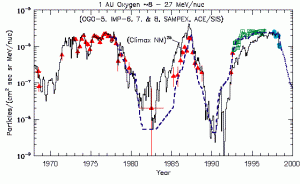Heliospheric Current Sheet Tilt model
The figure shows the intensity of anomalous cosmic ray (ACR) O at 1 AU as measured by a variety of observers over the last 30 years. The SAMPEX measurements are the green boxes. The solid line is proportional to the Climax neutron monitor rate (from the University of Chicago) raised to the 25th power. This curve, a measure of the intensity of high-energy galactic cosmic rays (GCRs), was normalized in such a way that it is a close match to the ACR O observations during the period 1971-78.
In a 1993 paper soon after the launch of SAMPEX we noted the much more rapid return of ACRs from 1992-93 as compared to GCRs. In an earlier SAMPEX science note we ascribed the different recovery rates to possibly a relatively large latitude gradient for ACRs in conjunction with a change in the heliomagnetic latitude of SAMPEX. Recently, Ulysses investigators have reduced the estimates of the magnitude of the latitude gradient, which lessens the likelihood that this explanation is correct.
However, a recent model of modulation of ACR O by Stone and Cummings (1999) (dashed blue curve in the figure), based on the tilt of the heliospheric current sheet (HCS) and radial gradient measurements in the outer heliosphere, may explain the 1 AU ACR O observations. In addition to matching the rapid rise of ACRs at 1 AU as observed by SAMPEX from 1992-93, the model appears to match the observations in the 1980’s better than the neutron monitor proxy. The dotted blue line from 1998.5 onward indicates the likely future trend of ACR O at 1 AU if the tilt observations of 20 years ago repeat themselves.
It still remains to explain the difference in the recovery rates of ACRs and GCRs in 1992-93. The GCRs could be less sensitive the HCS tilt angle or perhaps the spherically-symmetric source distribution for GCRs as compared to the latitude-dependent source location for ACRs plays some role.
Contributed by Alan Cummings and Dick Mewaldt, Caltech
«Return to the Results page
